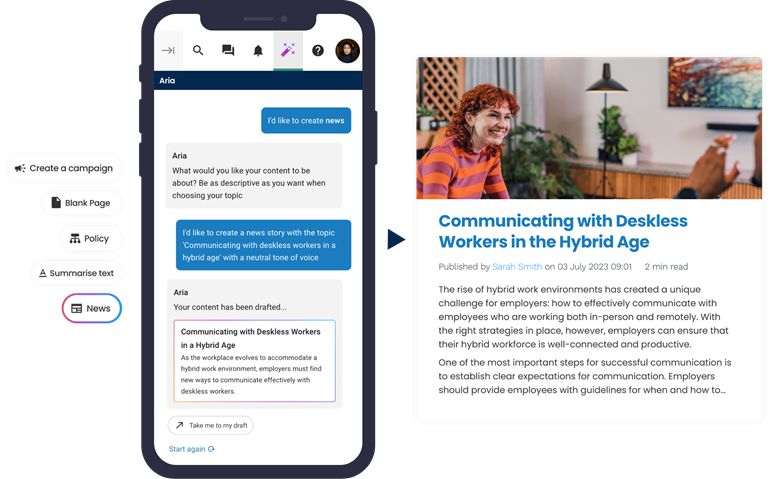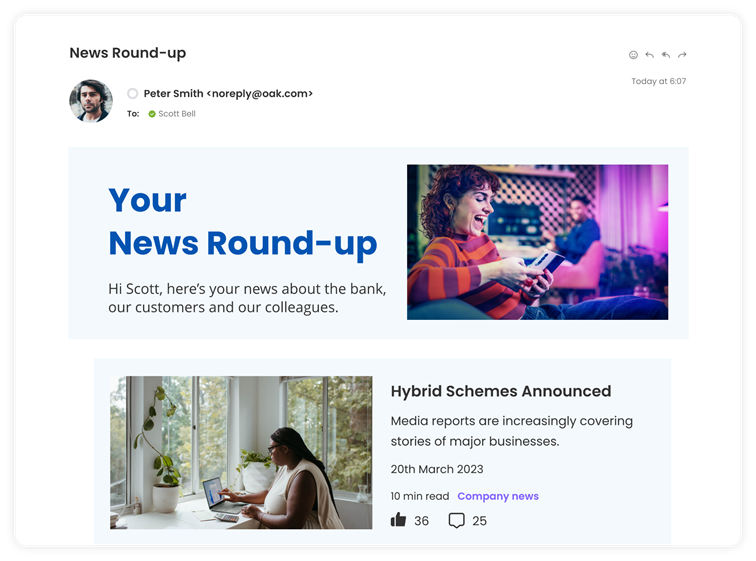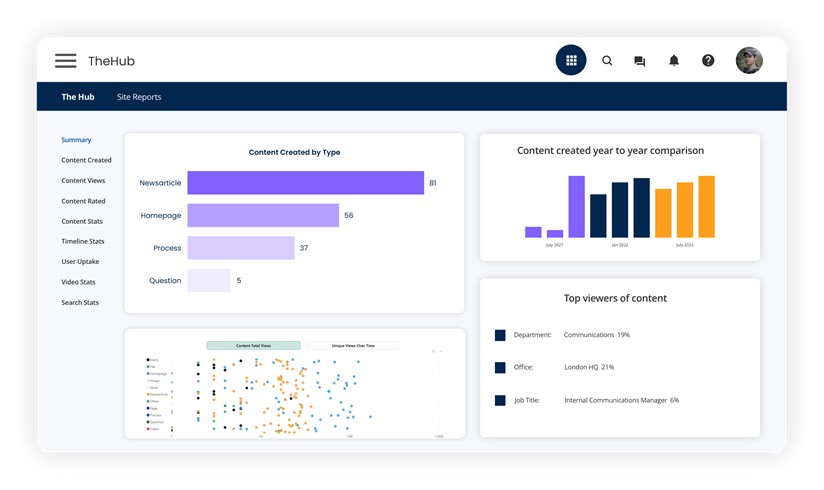Corporate communications is typically a fairly mundane and rudimentary process. It’s usually a means to an end for many businesses. When done right however, effective corporate comms can be a tool for engaging employees, reinforcing culture and driving alignment within your business. For any business to experience success, effective communication must be an overarching cornerstone of its approach. Making communication stick in the corporate world can be a difficult task. From low engagement to misalignment, corporate communication can be a minefield for the uninitiated and uneducated.
Thankfully, we’ve got you covered. We know corporate communications better than most. In fact, we deliver corporate communications to some of the world’s biggest companies and businesses. Our intranet solution has been designed to accommodate enterprise businesses, so we know a thing or two about how to communicate with employees on a large scale. In this blog, we’ll dive into the ins and outs of what constitutes great corporate communication, give you some tips and tricks on the techniques and much more..
What is corporate communications?
Corporate communications can be defined as the process of communicating in a professional capacity to employees or even external stakeholders. Corporate communication has been expedited by the introduction of new technology. For a while this was relegated to the traditional corporate intranets of the noughties and nineties. Business communication didn’t really expand much beyond the realms of noticeboard announcements and the odd email here and there. The fundamental need and requirements of workplace communication were apparent but the concepts surrounding internal communication were massively misunderstood and left virtually untouched. Whilst communication was carried out in its most basic format, it remained two-dimensional and didn’t take much into account the reception of its audience and whether they were even seeing it at all. The widespread use of the term employee engagement remained elusive until well into the 2010’s. Communication was limited to a very linear, top down approach. In today’s landscape, however, things are much more omnidirectional. Concepts surrounding message uptake and general engagement are much more commonplace.
Modern corporate communications encompasses not only the everyday but a multitude of direct and indirect interactions. From two-way email communication to blogs, policies, company updates, rotas and more, corporate communication is inherent in any businesses everyday operation. It defines how employees perceive, react and behave in their everyday environments. It can no longer be defined by one action, it is by extension, the entire employee experience.
Using a basic breakdown, we can understand corporate communications as
- The multiple formats by which we can communicate
- A way of connecting, engaging and aligning employees
- How messages are received and engaged with
- The multiple components of direct and indirect communication
Understanding corporate communications (with examples)
Generally speaking, corporate communications are used to keep employees informed, aligned and up to date with the latest developments within the company. Whilst this is a very superficial use of the term communication, this traditional mould has for the large part remained a staple of standard business operations. As mentioned previously, if we are to extend beyond this concept, we can understand that corporate communication reaches beyond employees and into the realms of extranets, branding and more. For the purposes of this blog however, we’ll stay focused on the element of employee communication. Here are a few examples of how some of the biggest brands in the world adopt their internal communication strategies and use internal communications software.
Microsoft: Microsoft places a strong emphasis on internal communication to foster employee engagement and alignment. The company uses various channels, such as an intranet portal, internal social media platforms, and regular town hall meetings, to keep employees informed about company news, updates, and strategic initiatives. Microsoft also encourages open communication and collaboration through platforms like Microsoft Teams, facilitating real-time communication and idea-sharing across the organisation.
Starbucks: Starbucks places a significant emphasis on internal communication to maintain consistent messaging and employee engagement across its vast network of stores. The company utilises multiple channels, such as an internal magazine called "Bean Stock," digital communication platforms, and leadership forums, to share important information, celebrate employee achievements, and provide ongoing training and development opportunities. Starbucks' corporate communications help create a unified employee experience and ensure that all staff members are aligned with the company's brand values and customer service standards.
Airbnb: Airbnb recognises the importance of effective internal communication in a distributed workforce. The company has implemented various initiatives to foster employee alignment and engagement. This includes regular virtual town hall meetings, online collaboration tools, and internal communication platforms. Airbnb also encourages open and transparent communication through channels like Slack, allowing employees to connect, share ideas, and stay informed about company updates and initiatives. These efforts contribute to a cohesive organisational culture and promote alignment with Airbnb's mission of creating belonging for travellers and hosts.
Leveraging intranets for internal comms
In today's digital age, intranets have emerged as a powerful tool for facilitating internal communications within organisations. An intranet is a private network that serves as an internal website, enabling employees to access and share information, collaborate on projects and communicate with one another. It has become an essential platform to enact effective internal communication, providing a centralised hub for employees to connect, engage and align with the organisation's goals and values. When trying to understand how an intranet for corporate communication can effectively contribute to your success, it’s important to see what they have to offer. In many instances, corporate workforces are large and operate as enterprises. For these businesses, it's important to make sure they have all the necessary enterprise intranet features and solutions in place to help them operate as efficiently as possible.
How intranets improve corporate communications
With the advent of technology around the 21st century, communicating with employees became a little bit easier and much more prominent. As with every technological advancement comes an element of commercialisation. Corporate communication is no different. Intranets for corporate communication were rolled out to align businesses and maintain a constant stream of communication with employees. Tools for corporate communication have evolved into complex and sophisticated software. Recent developments like AI promises internal communications a much more definitive and personalised future compared to their traditional counterparts. In fact, AI intranets offer a range of features that enhance internal communication and collaboration. After all, their inherent design is one that has been created around the very need for communicating with the business. Although every intranet is different, for the most part they have been able to offer employees much improved communication capacities than ever before. We’ve based this list off just a few of Oak Engage’s many capabilities:
AI intranet: An AI-powered intranet brings significant benefits to corporate communication by leveraging artificial intelligence. It enables personalised communication by analysing employee data and delivering targeted messages based on individual preferences. This personalisation enhances engagement and relevance in communication. Additionally, AI automation streamlines communication processes, saving time and increasing efficiency. Tasks like document categorisation and answering common queries can be automated, freeing up employees for more strategic work. AI-powered analytics provide valuable insights into communication effectiveness, allowing organisations to make data-driven decisions and continuously improve their communication strategies. Overall, an AI intranet enhances engagement, efficiency and effectiveness in corporate communication.

Document sharing and storage: Intranets provide a secure space for storing and sharing documents, enabling employees to access important information and resources anytime, anywhere. This streamlines communication and ensures that employees have the most up-to-date information at their fingertips.
News and announcements: Intranets serve as a central platform for sharing company news, updates, and announcements. This helps to keep employees informed about organisational changes, new initiatives and upcoming events, fostering a sense of transparency and inclusion.

Employee directories and profiles: Intranets often include employee directories and profiles, allowing employees to connect and collaborate more effectively. This feature encourages cross-departmental communication, facilitates knowledge sharing, and strengthens relationships among team members.
Discussion forums and collaboration spaces: Intranets offer interactive discussion forums and collaboration spaces where employees can share ideas, ask questions and collaborate on projects. These features promote engagement, foster innovation, and facilitate knowledge exchange within the organisation.
Improved access to information: Intranets provide a centralised repository of information, making it easier for employees to access relevant documents, policies and procedures. This improves efficiency, reduces the time spent searching for information and ensures consistency in communication.
Enhanced employee engagement: Intranets offer opportunities for two-way communication, allowing employees to provide feedback, share ideas and participate in discussions. This promotes a culture of inclusivity, empowers employees and increases their sense of belonging and engagement.
Streamlined internal communication: Intranets enable organisations to disseminate information quickly and efficiently. Through news feeds, notifications and targeted communication, important updates can be shared in a timely manner, ensuring that employees are well-informed and aligned with the organisation's goals.
Business benefits of intranets and internal comms
You’ve now read the various features an intranet like Oak Engage can offer, now it’s time to learn about the direct benefits and how it can positively affect your business.
Collaboration and knowledge sharing: Intranets provide platforms for collaboration, allowing employees to work together on projects, share best practices and learn from one another. This fosters a culture of collaboration and continuous learning, leading to increased productivity and innovation within the organisation. Effective corporate communications play a vital role in fostering employee engagement, alignment and overall business success. Here are some actionable tips and strategies to improve corporate communications within organisations:
Clear messaging: Crafting clear and concise messages is absolutely crucial for effective communication. The last thing you want is to leave your audience scratching their heads or drowning in a sea of corporate jargon. Instead, aim to make your messages easily understandable and perfectly aligned with your organisation's values and goals. Keep it simple, use plain language, and personalise your messages to specific audiences. By doing so, you'll skyrocket the clarity and comprehension levels, ensuring that your messages hit the bullseye every time.
Active listening: Communication is a vibrant dance between sender and receiver, and it's not just about broadcasting messages. It's a two-way street that thrives on active listening. Give your employees the chance to speak up, express their thoughts, voice their concerns and share their brilliant ideas.
But don't stop there – truly listen to their feedback and let it shape your decision-making processes. When you incorporate their insights, you show that their voices hold weight and that you value their unique perspectives. So, embrace the power of active listening and watch the magic unfold as your organisation becomes a symphony of collaboration and innovation.
Feedback loops: To foster a culture of continuous improvement, it's essential to establish feedback loops that keep the conversation flowing. Encourage your employees to be vocal and share their valuable insights on communication initiatives, channels and content. Embrace the power of evaluation by regularly assessing the effectiveness of your communication strategies.
And here's the secret sauce – don't just stop at evaluation; take action! Adjust and fine-tune your approaches based on the feedback you receive. By transforming feedback into actionable change, you'll create a dynamic and ever-evolving communication landscape that propels your organisation forward. So, let the feedback floodgates open and get ready to witness the remarkable growth that comes with a commitment to continuous improvement.
Leadership communication: Regularly share the organisation's vision, strategy, and progress with your employees. Paint a vivid picture of where you're headed, providing clarity and direction. Your communication should ignite a fire within your team, inspiring them to reach for greatness and conquer new horizons.
Remember, communication is a superpower in your leadership arsenal. Wield it wisely, delivering messages that resonate with authenticity and passion. Let your words be a beacon of inspiration, guiding your team to achieve extraordinary results. So, step into the spotlight, lead with intention and watch your organisation thrive under the influence of your powerful communication prowess.
Transparency and authenticity: When the going gets tough, be the beacon of truth and provide your team with the information they need. Transparent communication becomes the bedrock upon which trust is built, fostering a deep understanding of the reasons behind decisions. This understanding paves the way for enthusiastic buy-in and unwavering commitment from your employees. So, let transparency be your superpower, creating a culture where authenticity thrives and trust soars to new heights.
Effective internal communication campaigns: To truly captivate your audience, consistency is key. Let your messages shine with a radiant glow of relevance. Align them seamlessly with the organisation's values and goals, making them an irresistible call to action. With this winning formula, your internal communication campaigns will become the talk of the town, connecting employees on a deeper level and propelling them towards shared success. So, get ready to launch your campaign and watch the sparks fly as your team embarks on an extraordinary journey, fuelled by your strategic and engaging communication effort
Employee recognition and appreciation: Recognise and appreciate employees' contributions and achievements. Celebrate milestones, share success stories and acknowledge outstanding performance through various communication channels. This fosters a positive and supportive work environment. Through a symphony of communication channels, let's share their success stories far and wide. From the vibrant pulse of emails to the lively rhythm of social media, let's make sure their accomplishments echo throughout the organisation.
Crisis communication: Establish a crisis communication plan to effectively manage and communicate during challenging situations. Ensure that the plan includes designated spokespersons, clear protocols for information sharing and pre-prepared messaging templates. Act promptly, provide accurate and timely information, and address concerns and questions transparently to maintain stakeholder trust. By practising various crisis scenarios, your organisation can identify any gaps, refine the plan and train employees to respond effectively in high-pressure situations. These simulations can also help familiarise spokespersons with their roles and responsibilities, ensuring they are well-prepared to handle media interactions and provide consistent messaging.
Multichannel approach: Utilise a variety of communication channels to reach employees effectively. Consider the preferences and demographics of your workforce and select channels that resonate with them. Use a mix of face-to-face meetings, digital platforms, town hall sessions and mobile applications to ensure that messages reach all employees. While face-to-face meetings and town hall sessions allow for direct interaction and clarification of doubts, digital platforms and mobile applications can provide real-time updates and reach employees who may be geographically dispersed or working remotely.
Measure and evaluate: Tools for corporate communication are only as effective as the data you can glean from them. Platforms like Oak Engage utilise mechanisms including analytics to measure the effectiveness of communication initiatives. Use surveys, feedback forms, and analytics to gather data on employee satisfaction, comprehension and engagement. Regularly evaluate the impact of communication strategies and make adjustments based on the insights gained.

Oak Engage and corporate communications
In summary, our corporate intranet solution offers a comprehensive set of tools and features that address the complexities of modern day business communication. If you’re looking for a tool for corporate communication, then the search ends here. By centralising communication, streamlining information sharing and enhancing employee engagement, it provides a robust platform for effective internal communication. With scalability, measurement capabilities and a focus on improving employee experience, our intranet is the appropriate solution for organisations looking to overcome the challenges and maximise the benefits of corporate communication. Effective corporate communication plays a vital role in managing challenging situations and maintaining stakeholder trust.
Designating spokespersons, implementing clear information-sharing protocols and utilising pre-prepared messaging templates ensure consistent and transparent communication. Moreover, leveraging a variety of communication channels helps reach and engage employees effectively, considering their preferences and demographics. Regularly measuring the impact of communication initiatives through surveys, feedback forms and analytics allows for continuous improvement and adjustment of strategies.
By implementing the strategies discussed, you can strengthen your organisation's ability to navigate challenging situations and protect its reputation. Whether it's designating spokespersons, refining information-sharing protocols, or diversifying communication channels, every action counts. Remember, preparation is key in effectively managing crises. Reach out to us for expert guidance and support in improving your corporate communication capabilities with Oak Engage.



